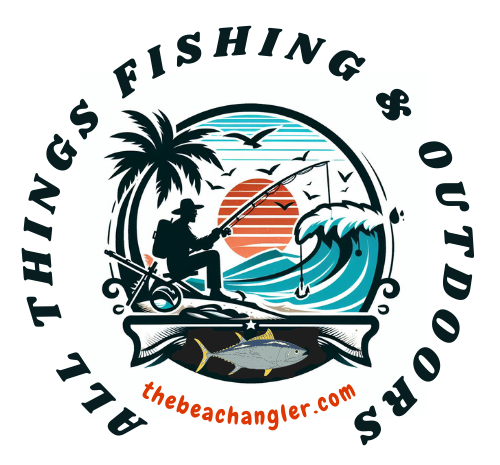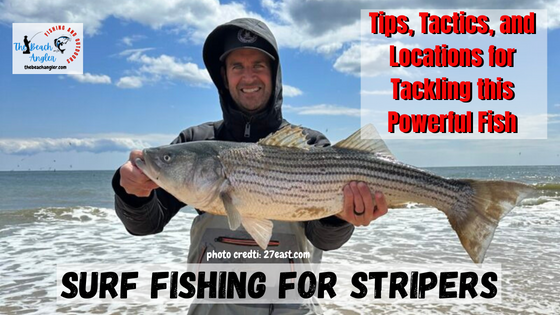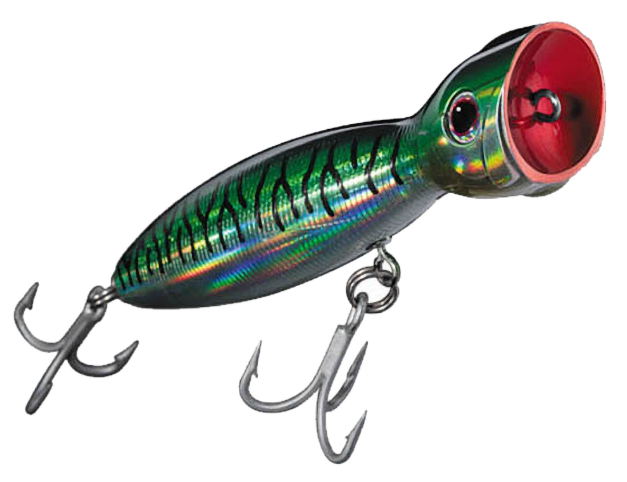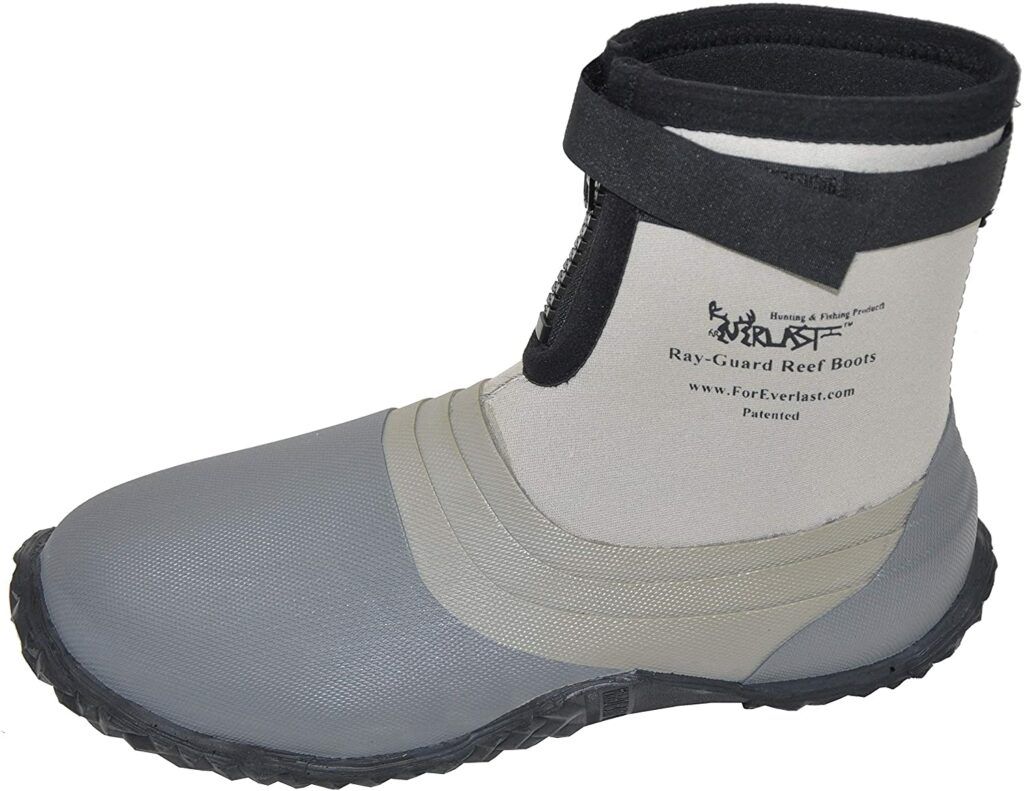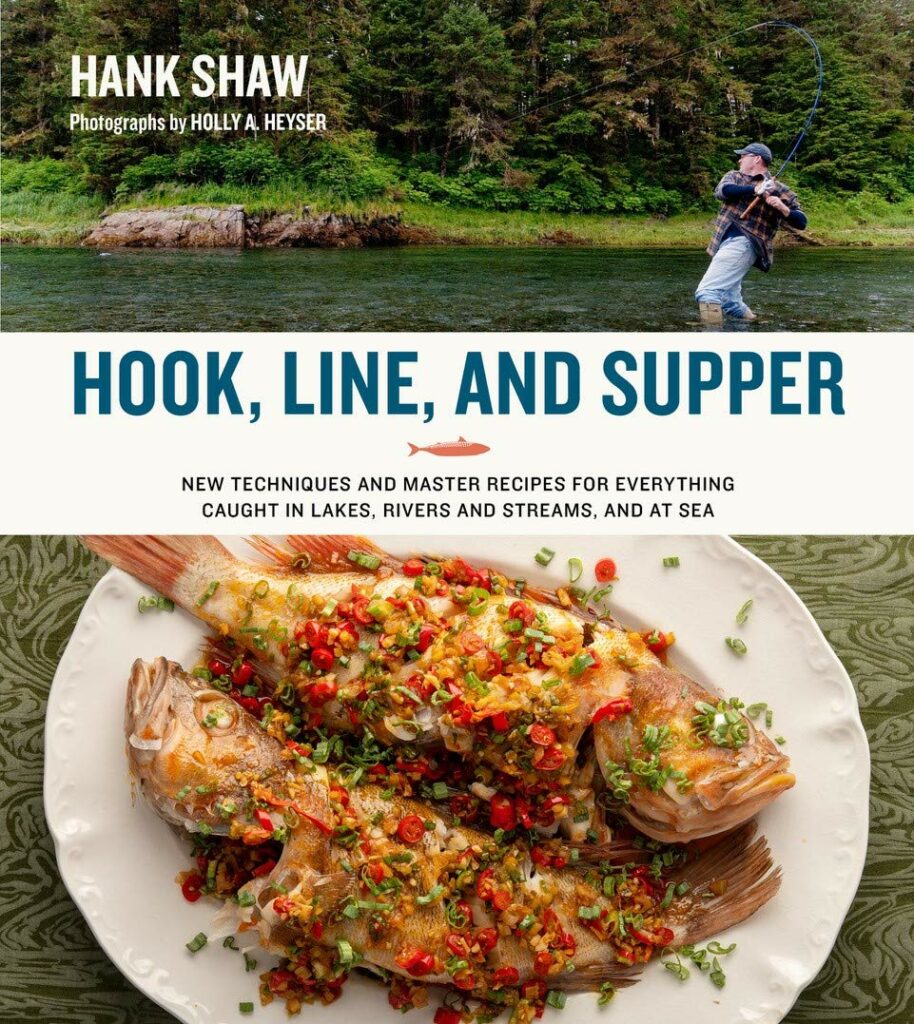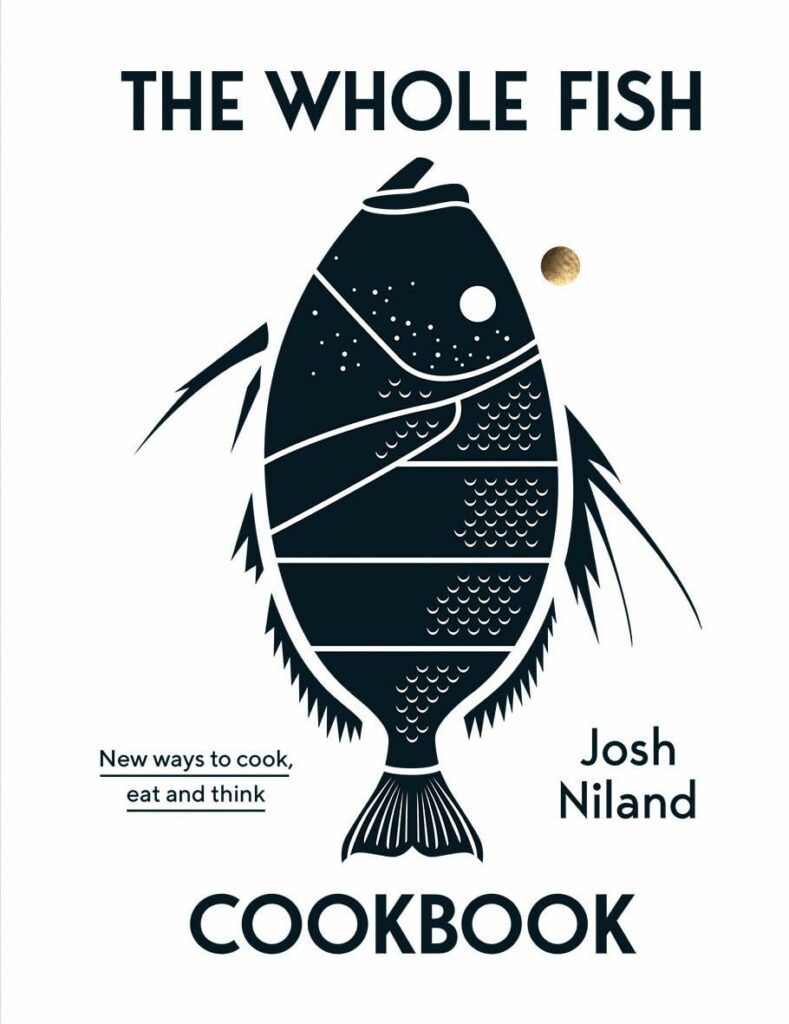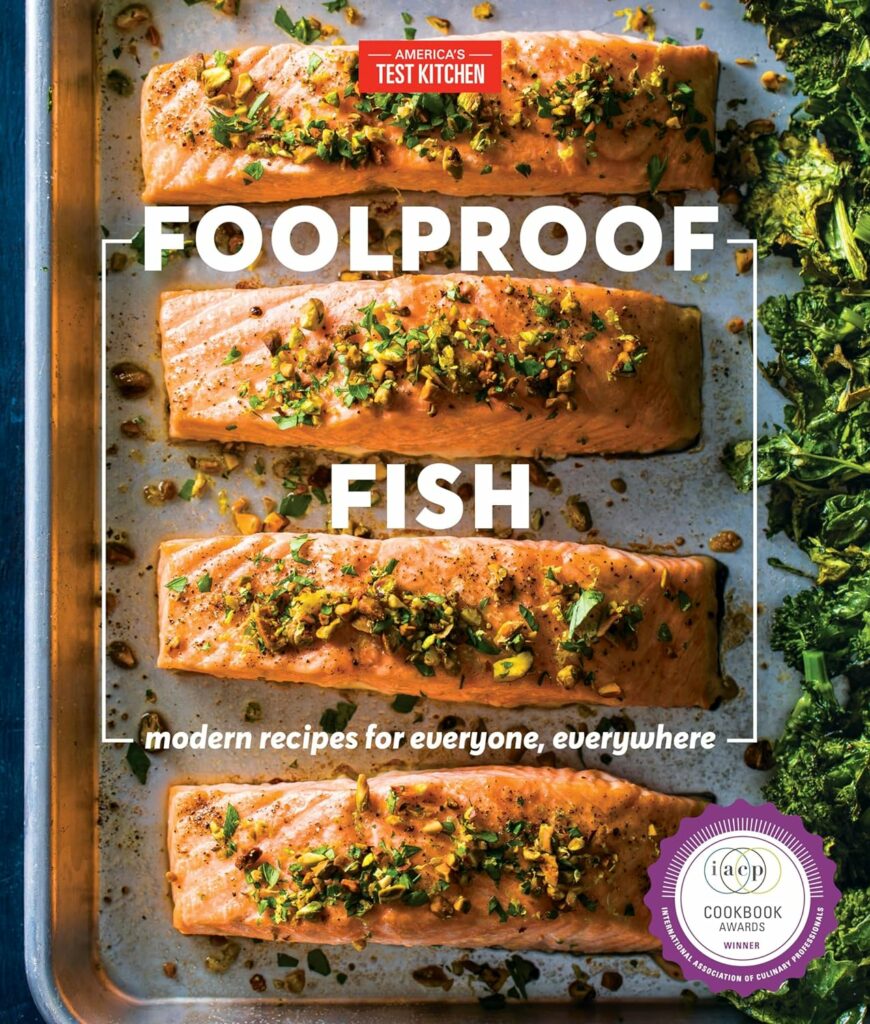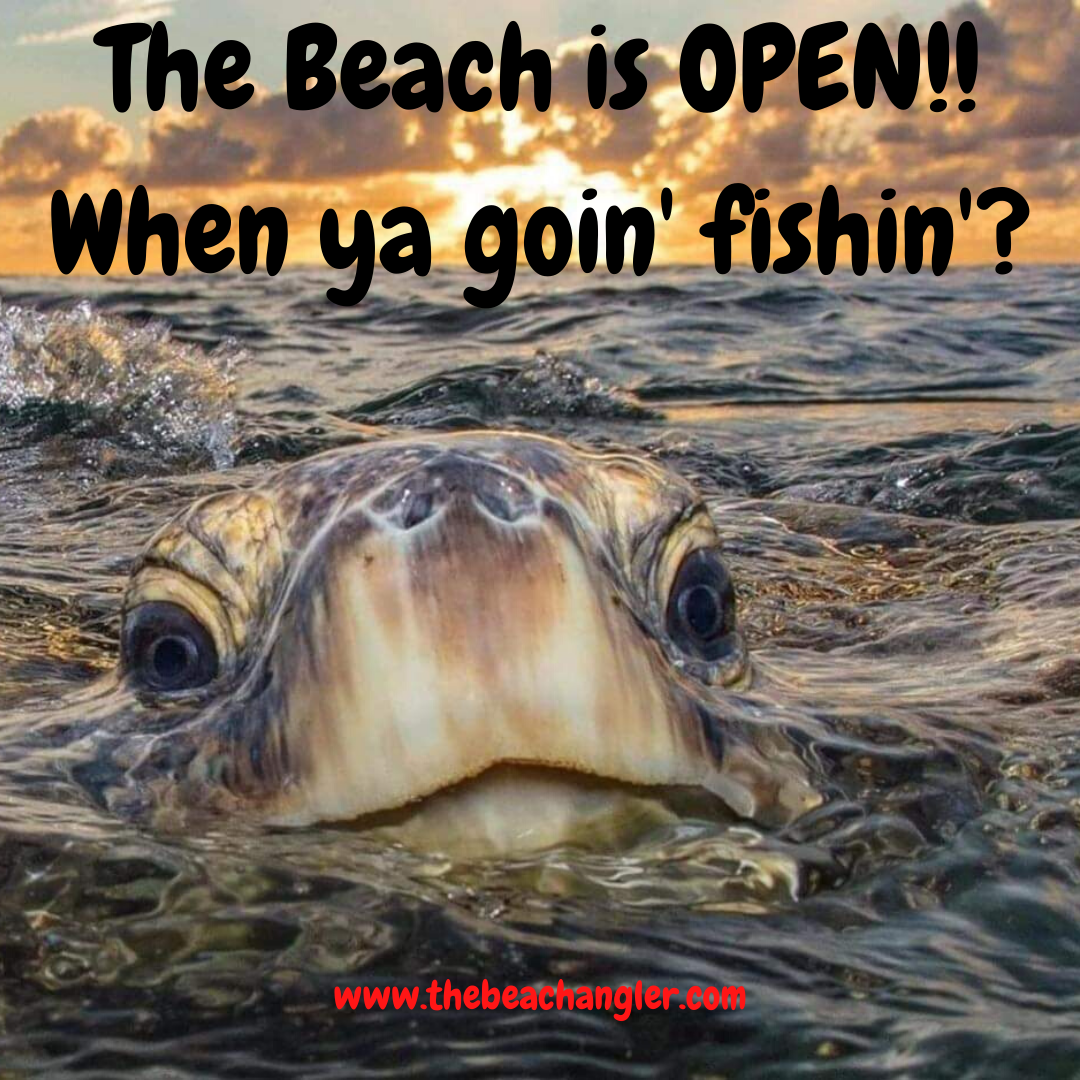Striped bass, also known as stripers, are a highly sought-after game fish that can be found along the Atlantic coast of North America, the San Jouquin and Sacramento river systems of California and even along the beach front, and they have even been stocked in many freshwater lakes. For decades, surf fishing for stripers has been a popular method of pursuing this powerful game fish.
Quick Summary:
Surf fishing for stripers is an exciting and challenging fishing adventure. By understanding the basics, using the right gear, and adopting some proven tips and tactics, you can increase your chances of landing that trophy-sized striper. Additionally, pay attention to any regulations or permits required for fishing in specific areas. Found Primarily along the Atlantic coast of the U.S., with the Outer Banks of North Carolina along with the coasts of Virginia, New York and New Jersey being prime spots to try your hand at surf fishing for stripers.
Stripers are known for their strong fight and excellent table fare, and Surf fishing for stripers is a great way to enjoy the outdoors and catch some fish at the same time.
Whether you’re a seasoned angler or a beginner, surf fishing provides an opportunity to test your skills against one of the most popular game fish along the coast.
I have had some great times catching Stripers, and can testify to their strong fight and great taste.
Come along and we’ll dive into the exciting world of surf fishing for stripers and provide you with the tips and tricks you need to reel in one of the ultimate trophy surf fish.
Everything from the best places to fish, to the essential gear you need, we’ve got you covered on how to surf fish for stripers.
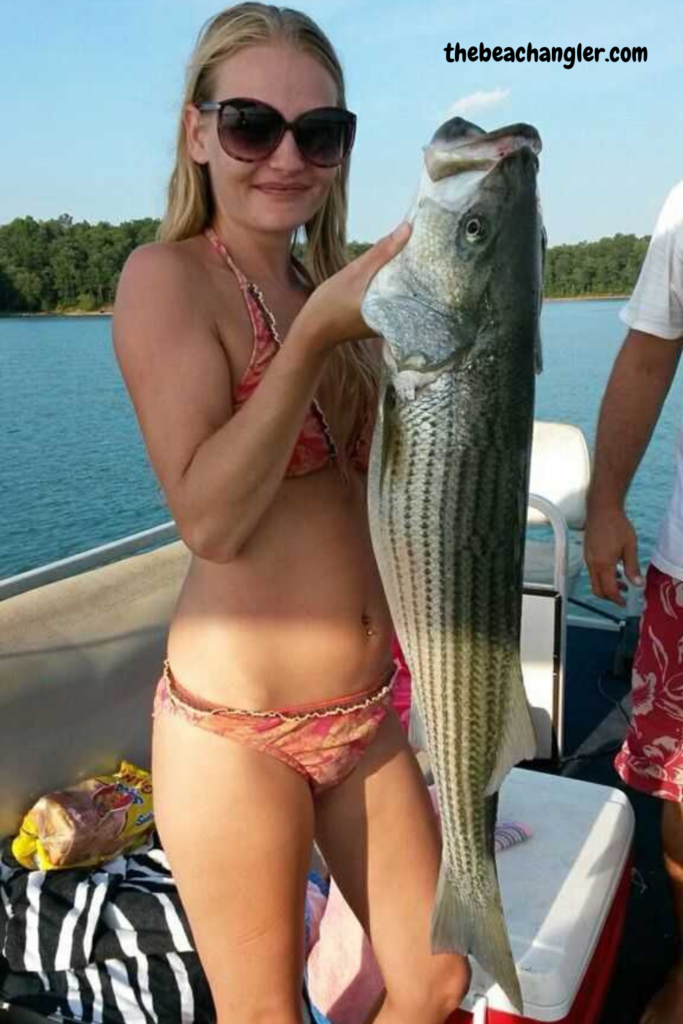
Understanding Striped Bass (Stripers)
What is a Striper?
Stripers, also known as Striped bass, are a highly sought-after game fish that can be found primarily along the Atlantic coast of North America. They are known for their silver body with distinct dark horizontal stripes running along their sides. Stripers can grow to impressive sizes, with some individuals exceeding 50 pounds. The average size in length is 20 to 35 inches (50–90 cm) and approximately 5 to 20 pounds (2–9 kg). The common mature size is 20 to 40 pounds (9–18 kg). Striped bass are believed to live for up to 30 years.
The largest recorded Striped Bass was 124 pounds (56 kg), netted in 1896. An 81.88 lb (37.14 kg) specimen taken from a boat in Long Island Sound, near the Outer Southwest Reef, off the coast of Westbrook, Connecticut is currently the largest striped bass ever taken by an angler. The all-tackle world record fish was taken by Gregory Myerson on the night of August 4, 2011.
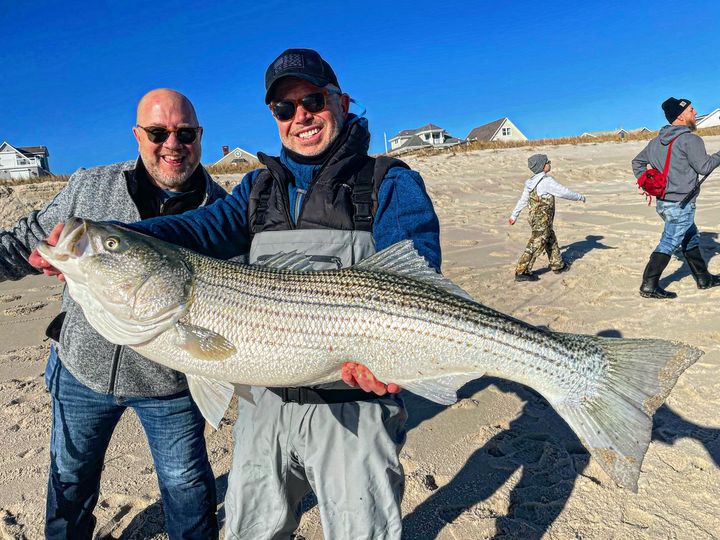
Striped bass spawn in fresh water, and although they have been successfully adapted to freshwater habitat, they naturally spend their adult lives in saltwater. The very few successful spawning populations of freshwater striped bass include Lake Texoma, Lake Weiss (Coosa River), the Colorado River and its reservoirs downstream from and including Lake Powell, and the Arkansas River, as well as Lake Marion (South Carolina) that retained a landlocked breeding population when the dam was built; other freshwater fisheries must be restocked with hatchery-produced fish annually.
Striped bass have also been hybridized with white bass to produce hybrid striped bass also known as wiper, whiterock bass, sunshine bass, palmetto bass, and Cherokee bass. These hybrids have been stocked in many freshwater areas across the US.
The Basics of Surf Fishing for Stripers
Surf fishing for stripers involves casting your line from the shoreline into the surf zone, where stripers often feed. Before heading out, it’s important to familiarize yourself with the basics of surf fishing. This includes understanding the different components of a surf fishing setup, such as rods, reels, lines, and rigs. Additionally, learning how to cast, read the surf, and where and when can you find stripers in the surf.
Essential Gear for Surf Fishing
To have a successful surf fishing trip, you need to ensure you have the right gear. Here are some essential items you should include in your surf fishing arsenal:
- Surf Fishing Rod: Opt for a sturdy, medium to heavy action rod that can handle the weight and power of stripers. A long surf rod is necessary for casting long distances. Look for a rod that is at least 9 feet long and has a fast action.
- Spinning Reel: Choose a reel with a smooth drag system and sufficient line capacity to handle long casts and strong fish. A good quality spinning reel is good choice for surf casting. Look for a reel that can hold at least 200 yards of 20-pound test line.
- Fishing Line: Use a high-quality monofilament line with a pound-test rating suitable for the size of stripers in your area. Or, use a braided line for its strength and sensitivity, coupled with a fluorocarbon leader to prevent fish from seeing the line.
- Terminal Tackle: This includes hooks, sinkers, swivels, and leaders. Select appropriate sizes based on the fishing conditions and the size of stripers you’re targeting. A fish finder rig is a popular rig used by surf fishermen. It consists of a sliding sinker above a swivel and leader with a hook at the end. Circle hooks are required by law in some states when fishing with bait. They are designed to hook the fish in the corner of the mouth, which reduces mortality rates when practicing catch and release.
- Bait and Lures: Stripers are opportunistic feeders, so have a variety of live bait, such as eels or bunker, as well as artificial lures like topwater plugs and soft plastic swimbaits. Stripers are known for their voracious appetites. Experimenting with different bait and lure options can help you identify what works best for your specific fishing location and conditions.
- Waders or Surf Fishing Boots: Stay comfortable and dry by investing in a pair of waders or surf fishing boots, especially if you plan on wading into the water.
Best Places to Try Surf Fishing for Stripers
The first step in surf fishing for stripers is finding the best places to fish. Stripers can be found in a variety of locations along the coast.
Finding the right location is crucial for a successful surf fishing trip. Stripers often frequent areas with structure, such as jetties, sandbars, and rocky outcrops.
Research local fishing reports, talk to fellow anglers, and consider factors like water depth, current patterns, and underwater features when selecting your fishing spot. Some of the best places to surf fish for stripers include:
Jetties: Jetties are man-made structures that extend out into the water. They are great places to fish for stripers because they provide cover and structure for baitfish.
Passes and Inlets: Inlets are where rivers or streams meet the ocean. They are great places to fish for stripers because they provide a steady flow of baitfish and migration paths to freshwater for spawning.
Sandbars and Troughs: Look for areas where there are sandbars or troughs close to shore. These areas are often where baitfish congregate, which in turn attracts stripers.
Best Times to Surf Fish for Stripers
Striped bass have distinct migration patterns, and their availability can vary depending on the season. The spring and fall are known to be productive for surf fishing for stripers:
In the spring, as the water warms up, stripers migrate from their winter grounds, making spring an excellent time to target them.
As the weather cools in the fall, stripers embark on their annual fall migration, feeding voraciously to fatten up before winter. The fall run is highly anticipated by anglers and is often considered the best time to catch trophy-sized stripers.
Early morning and evening hours also tend to be productive. However, don’t limit yourself to these times alone, as stripers can be caught throughout the day under the right conditions.
Tides and Their Impact on Stripers
Understanding the relationship between tides and fishing is vital for surf fishing success. Stripers tend to be more active during specific tidal phases. As a general rule, the incoming and outgoing tides, often referred to as the “turning of the tide,” are prime times for stripers to feed. Surf fishing in general is better when there is tidal movement, either in or out, as this moves baitfish and the stripers will follow.
As the tide rises, it brings in an abundance of baitfish, attracting stripers closer to the shoreline in search of an easy meal.
During the outgoing tide, stripers tend to follow the baitfish as they move away from the shoreline. Fishing the channels and cuts can be productive during this time.

When the tide is neither incoming nor outgoing, stripers may become less active. However, they can still be caught by presenting your bait in strategic locations.
Surf Fishing for Stripers: Tips and Tactics
Now that you have the right gear and understand the best seasons and tides, let’s explore some effective techniques for surf fishing for stripers:
Surf Fishing with Artificial Lures
Lure fishing is a popular technique used by surf fishermen. Some of the best lures for stripers include topwater plugs, soft plastics, and metal jigs. Lure fishing is a versatile technique that allows you to cover a large area of water. You can even catch stripers fly fishing the surf.
Cast your line beyond the breaking waves and let it settle. Slowly retrieve your lure, mimicking the movement of a wounded or fleeing baitfish. Hold on and pay attention to any strikes or changes in resistance, as stripers often hit their prey aggressively.
Bottom Fishing with Live or Dead Baits
Bottom fishing, with live or fresh dead bait, is a classic technique that works well for stripers. This involves casting your baited hook onto the bottom and allowing it to sit, enticing stripers feeding near the shoreline.
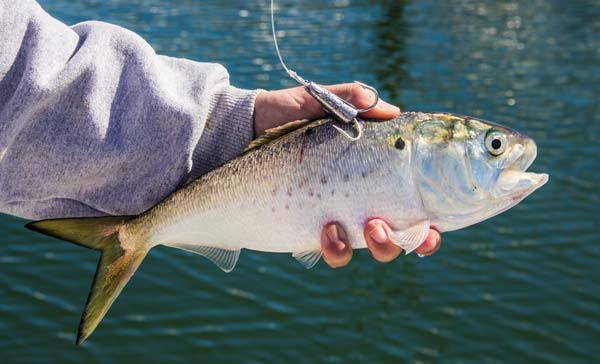
Bait fishing is one of the most popular techniques used by surf fishermen. Some of the best baits for stripers include clams, sandworms, eels, and bunker. Follow these steps to increase your chances of success:
Use a fishfinder rig or a Carolina rig with a pyramid sinker to keep your bait close to the ocean floor. Cast your line into an area with structure, such as rocks or jetties, where stripers like to hide and ambush their prey.
Allow your bait to settle on the bottom and remain patient. Stripers may take their time before striking. You can also try drift Fishing by using a rig that allows your bait to drift naturally with the current. This can be an effective way to cover a larger area and locate actively feeding fish.
Handling and Releasing Stripers
As responsible anglers, it’s crucial to handle stripers with care to maximize their chances of survival after catch and release. Wet your hands before handling a striper to minimize damage to their protective slime coating.
Avoid placing excessive pressure on the fish’s gills and organs. If possible, keep the fish in the water while removing the hook and minimize the time it spends out of the water. Follow these best practices for catch and release:
Use barbless hooks, which can be easily removed and cause less harm to the fish. Minimize the time the fish spends out of the water and handle it gently to reduce stress and injury. If necessary, revive the fish by holding it upright in the water, allowing it to regain its strength before swimming away.
Safety Tips for Surf Fishing
While surf fishing can be an enjoyable experience, it’s essential to prioritize safety. Here are some safety tips to keep in mind:
- Be Aware of Waves: Pay attention to the surf conditions and be cautious of large waves or strong currents.
- Use Proper Footwear: Wear appropriate footwear with good traction to navigate slippery rocks and uneven terrain.
- Stay Hydrated: Bring plenty of water to stay hydrated, especially during hot weather.
- Protect Yourself from the Sun: Apply sunscreen, wear a hat, and consider UV protective clothing to shield yourself from harmful sun rays.
- Wear a PFD: If you will be wading the surf, it is recommended that you wear a personal flotation device. Even the strongest swimmers can be swept off their feet by strong rip currents and waves.
Surf Fishing Etiquette
Respecting other anglers and the environment is essential when surf fishing. Follow these etiquette guidelines:
- Give Space: Avoid crowding other anglers and provide ample space between fishing spots.
- Clean up: Dispose of any trash properly and leave the fishing area cleaner than you found it.
- Be Respectful: Be mindful of noise levels, avoid trespassing on private property, and follow any specific rules or regulations in the area.
Planning Your Surf Fishing Trip
Before embarking on a surf fishing trip, it’s important to plan and prepare. Monitor the weather forecast to ensure safe and favorable conditions for surf fishing. Bring all necessary fishing gear, including backup equipment, and pack food, water, and any additional items you may need.
Familiarize yourself with local fishing regulations, including size and bag limits, as well as any permits or licenses required. Check with the local online fishing forums, and local bait shops and fishing guides for the latest on conditions, baits and successful tactics.
The Best Surf Fishing Spots for Stripers
When it comes to surf fishing for stripers, location is key. These prized fish can be found along the coastlines of various regions, providing ample opportunities for anglers to test their skills. Here are some of the best surf fishing spots for stripers:
- Cape Cod, Massachusetts: Known for its abundant striped bass population, Cape Cod offers excellent surf fishing opportunities.
- Outer Banks, North Carolina: The Outer Banks provide a perfect combination of structure, tides, and baitfish, making it a prime spot for stripers.
- Montauk, New York: Located at the eastern tip of Long Island, Montauk is renowned for its legendary fall run, attracting anglers from all over.
- Chincoteague Island, Virginia: This barrier island, just across the bay from Virginia Beach, is a hidden gem for surf fishing, with stripers making their way through the area during their migration.
- Cape Hatteras, North Carolina: With its wide sandy beaches and strong currents, Cape Hatteras is a magnet for striped bass.
Stripers for the Dinner Table
Are stripers good eating?
Yes, very much so, striped bass tastes absolutely delicious. The flesh is white and flaky with enough fat to make it seem almost buttery the primary flavor is sweet and briny, without a hint of fishy flavor.
Broiled Striped Bass with Ginger-Scallion Oil
Ingredients
- 4 scallions, thinly sliced
- 2 tablespoons minced fresh ginger
- 1 garlic clove, minced
- Pinch of crushed red pepper flakes
- 1/4 cup vegetable oil
- 2 tablespoons fresh lemon juice
- 1 teaspoon soy sauce
- 1 teaspoon kosher salt
- Four 5-ounce skinless striped bass fillets (about 1 inch thick)
Directions
- In a bowl, combine the scallions, ginger, garlic, and red pepper. In a saucepan, heat the oil until shimmering. Pour the hot oil over the scallion mixture and stir in the lemon juice, soy sauce, and salt.
- Preheat the broiler. Brush the fillets on both sides with some of the scallion oil. Arrange on a broiler pan skinned side down; broil until just cooked through, about 5 minutes.
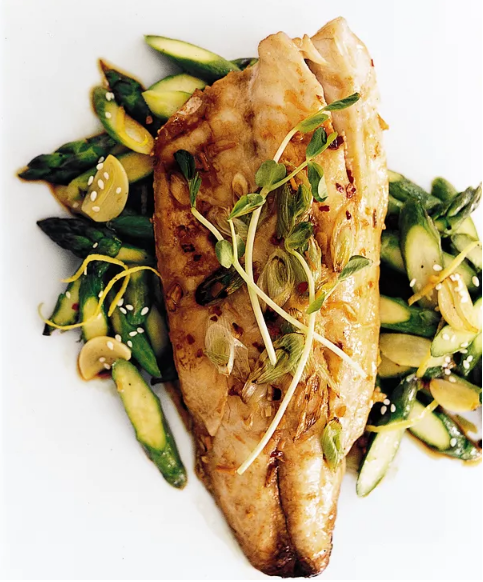
Surf Fishing for Stripers Frequently Asked Questions

Can I surf fish for stripers from any beach?
Surf fishing for stripers is possible from many coastal beaches, but it’s essential to research and select locations known for striper activity. Some beaches may have restrictions or regulations, so it’s best to check before you go.
What is the best time of year to surf fish for stripers?
Striper activity can vary depending on the region and time of year. Generally, spring and fall are prime seasons for surf fishing as stripers migrate along the coast. However, stripers can be caught year-round in certain areas.
What is the best time of day to surf fish for stripers?
Stripers can be caught throughout the day, but many anglers find that the hours around sunrise and sunset are particularly productive.
What is the recommended pound-test line for surf fishing stripers?
The pound-test line you should use for surf fishing stripers depends on the size of the fish you’re targeting and the fishing conditions. A good starting point is a 20 to 30-pound test line, but you may need to adjust based on your specific circumstances.
How far should I cast my line when surf fishing for stripers?
It’s generally recommended to cast beyond the breaking waves to reach the deeper water where stripers often patrol. However, the optimal casting distance can vary depending on the specific fishing conditions, so be adaptable and adjust your casts accordingly.

Are there any specific regulations for catching and keeping stripers?
Yes, there are regulations in place to protect the striped bass population. These regulations may include size limits, bag limits, and closed seasons. It’s important to familiarize yourself with the local fishing regulations and adhere to them.
Do I need a fishing license for surf fishing for stripers?
Yes, a fishing license is required in most states for surf fishing. Make sure to check the local regulations and obtain the necessary permits before heading out.
Can I use artificial lures instead of live bait for surf fishing stripers?
Absolutely! Artificial lures can be highly effective for surf fishing stripers. They offer versatility and allow you to cover more water. Experiment with different lures to find what works best in your fishing location and conditions.
What are some common lures for surf fishing for stripers?
Popular lures for stripers include topwater plugs, soft plastic baits, bucktail jigs, and swimming plugs. Experiment with different colors and sizes to see what works best in your fishing area.
Give Surf Fishing for Stripers a Shot
Picture yourself standing on a picturesque beach, casting your line into the rolling surf as the sun sets on the horizon. The anticipation builds as you feel the tug on your line, signaling that a striper is on the other end. It’s a thrilling encounter that will leave you with memories to last a lifetime.
Surf fishing for stripers is an exciting and challenging fishing adventure. By understanding the basics, using the right gear, and adopting some proven tips and tactics, you can increase your chances of landing that trophy-sized striper. Additionally, pay attention to any regulations or permits required for fishing in specific areas. Surf fishing for stripers offers a unique and thrilling experience that combines the tranquility of the ocean waves with the exhilaration of battling a powerful fish.
Remember to keep only what you can use, and practice safe catch and release whenever possible to ensure the sustainability of the striped bass population for future generations of anglers to enjoy.
Respect the fishing regulations, so you stay on the good side of the Fish and Game Officer, and enjoy the beauty of the coastal environment while trying your hand at surf fishing for stripers and get ready for an adventure you won’t soon forget!
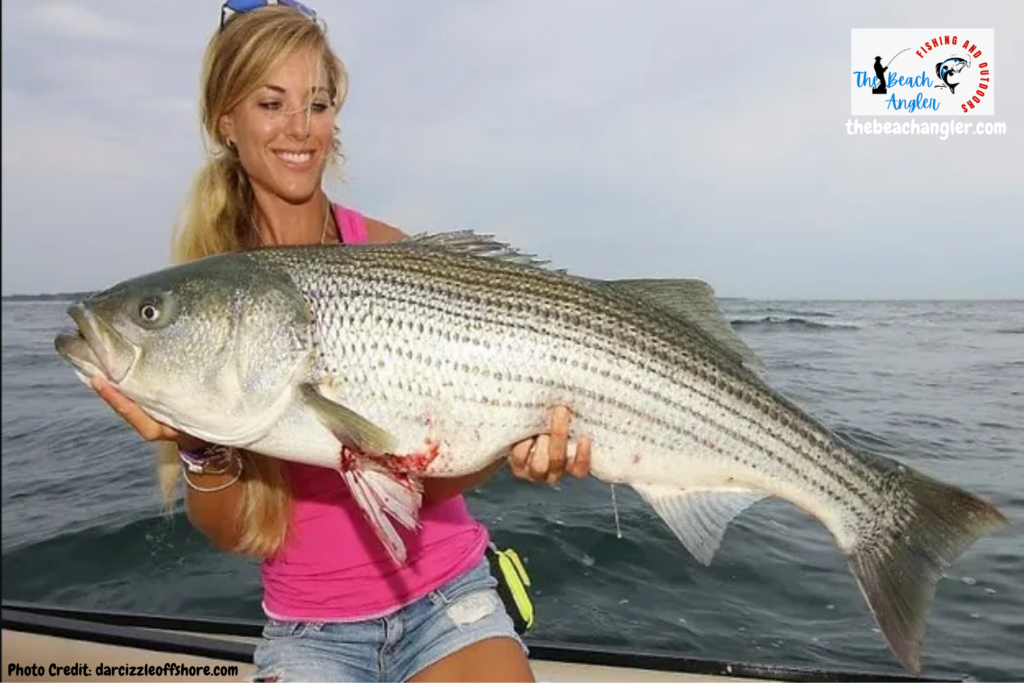
As always, stay safe, enjoy the journey and please try to leave it cleaner than you found it. If you have any comments, questions, ideas or suggestions please leave them in the comment section below and I’ll get back to you asap. You can follow us on Facebook: Rex The Beach Angler, Instagram: thebeachangler7, Twitter: @AnglerBeach, and YouTube: Man Art Creations.
P.S. – Thanks so much for checking out our blog we really appreciate it. Just so you know, we may receive a commission if you click on some of the links that appear on our site. This helps us keep our content free and up-to-date for everyone. We appreciate your support!
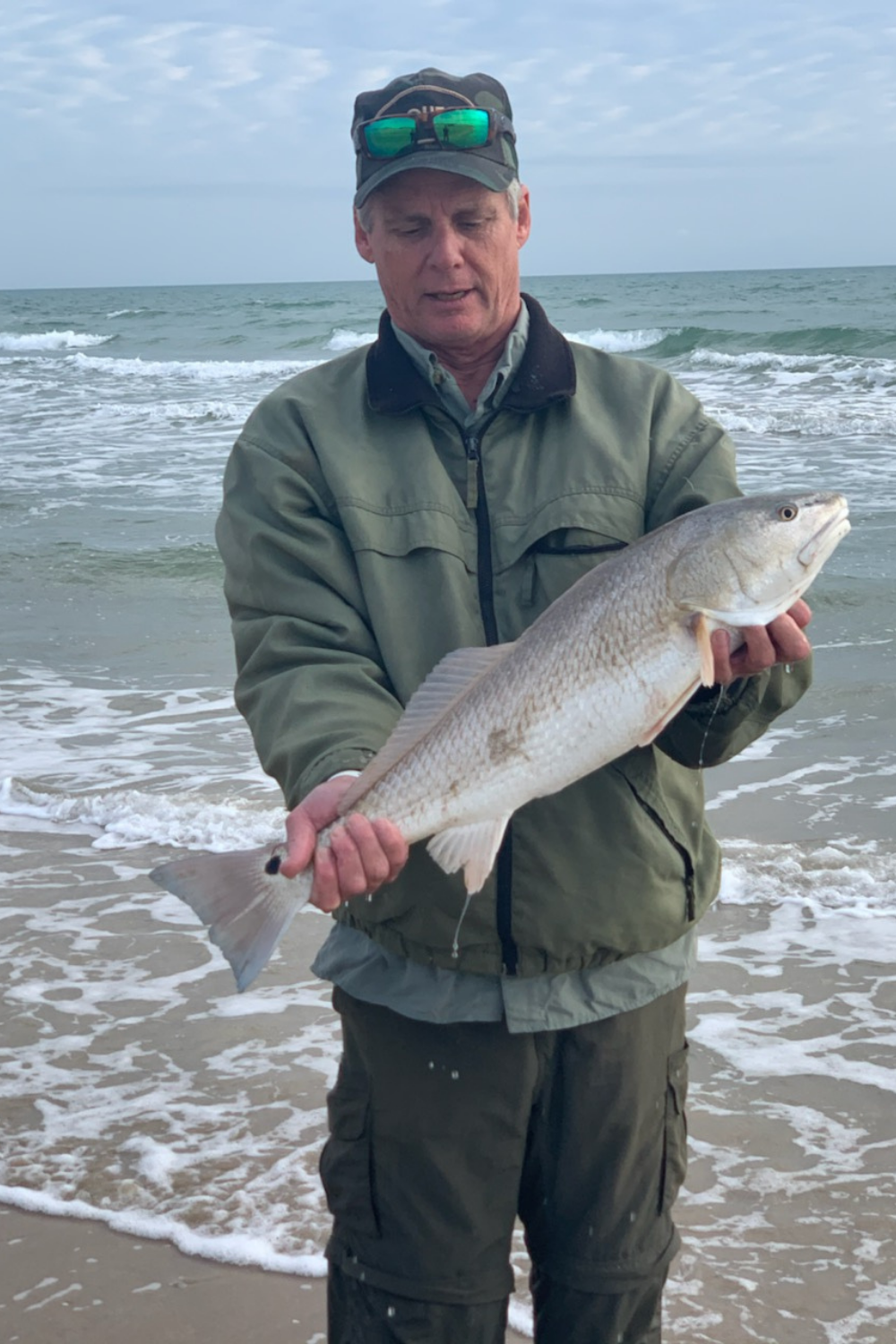
A life long surf fisherman with 50+ years of experience, I am also an avid hunter and outdoorsman. I will be sharing my passion for the outdoors with you so be prepared for hunting, fishing, camping, hiking and more. Along with gear reviews and the latest trends and innovations in the outdoor industry.
